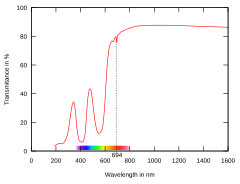

In optical physics, transmittance of the surface of a material is its effectiveness in transmitting radiant energy. It is the fraction of incident electromagnetic power that is transmitted through a sample, in contrast to the transmission coefficient, which is the ratio of the transmitted to incident electric field.[2]
Internal transmittance refers to energy loss by absorption, whereas (total) transmittance is that due to absorption, scattering, reflection, etc.
- ^ "Electronic warfare and radar systems engineering handbook". Archived from the original on September 13, 2001.
{{cite web}}: CS1 maint: unfit URL (link) - ^ IUPAC, Compendium of Chemical Terminology, 2nd ed. (the "Gold Book") (1997). Online corrected version: (2006–) "Transmittance". doi:10.1351/goldbook.T06484